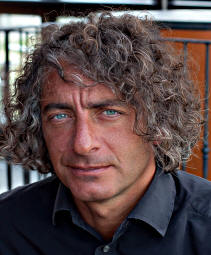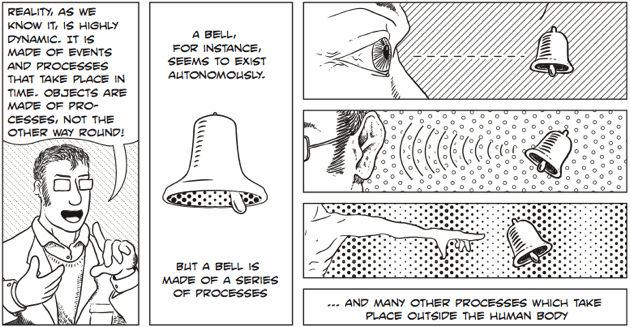“There are no images.” This was the first time I noticed Riccardo Manzotti. It was a conference on art and neuroscience. Someone had spoken about the images we keep in our minds. Manzotti seemed agitated. The girl sitting next to me explained that he built robots, was a genius. “There are no images and no representations in our minds,” he insisted. “Our visual experience of the world is a continuum between see-er and seen united in a shared process of seeing.”
I was curious, if only because, as a novelist I’d always supposed I was dealing in images, imagery. This stuff might have implications. So we had a beer together.
Manzotti has a degree in engineering and another in philosophy. He teaches in the psychology department at IULM University, Milan. The move from engineering to philosophy was prompted by conceptual problems he’d run into when first seeking to build robots. What does it mean that a subject sees an object? “People say the robot stores images of the world through its video camera. It doesn’t, it stores digital data. It has no images.”
Manzotti is what they call a radical externalist: for him consciousness is not safely confined within a brain whose neurons select and store information received from a separate world, appropriating, segmenting, and manipulating various forms of input. Instead, he offers a model he calls Spread Mind: consciousness is a process shared between various otherwise distinct processes which, for convenience’s sake we have separated out and stabilized in the words subject and object. Language, or at least our modern language, thus encourages a false account of experience.
His favorite example is the rainbow. For the rainbow experience to happen we need sunshine, raindrops, and a spectator. It is not that the sun and the raindrops cease to exist if there is no one there to see them. Manzotti is not a Bishop Berkeley. But unless someone is present at a particular point no colored arch can appear. The rainbow is hence a process requiring various elements, one of which happens to be an instrument of sense perception. It doesn’t exist whole and separate in the world nor does it exist as an acquired image in the head separated from what is perceived (the view held by the “internalists” who account for the majority of neuroscientists); rather, consciousness is spread between sunlight, raindrops, and visual cortex, creating a unique, transitory new whole, the rainbow experience. Or again: the viewer doesn’t see the world; he is part of a world process.
Everything we see, hear, touch, taste, and smell, Manzotti argues, involves the same creation of a physical unity—the moment of consciousness—sustained by processes within and without the head. The room, or part of a room, that you see now, including the screen on which you’re reading this blog, becomes, in combination with your faculties, a whole; this is consciousness. It happens in time, and it takes time (consciousness of visual phenomena seems to require at least 100 milliseconds to occur), and it changes constantly.
This minimal time lapse (some claim it is as much as 500 milliseconds) required for brain and world to generate consciousness allows Manzotti to deal with what would seem to be the obvious objection to the externalist theory. Do we not have consciousness when the eyes are shut and the mind lies in silence? And what about dreams? Isn’t the brain evidently sufficient to sustain consciousness without support from outside?
We do indeed have consciousness in these moments, Manzotti replies, but it is still spread out between mind and world. It may take only a fraction of a second for you to become conscious of the face appearing at your window, and then three more years before the same face surfaces in a dream, perhaps mingled with all kinds of other stimuli from elsewhere. But this doesn’t change the fact that consciousness is a coming together of brain and world: the physical process begun at the window is continuing in memory and dream. The congenitally blind, Manzotti points out, don’t dream colors because they have never encountered them. Consciousness is the mingling of mind process with the processes we call objects that are all in a state of flux, however fast or slow.
Let’s leave aside the gospel truth or otherwise of all this. I tend to be skeptical of people with big ideas and Manzotti, like Einstein I suppose, has the long unkempt hair and animated manner of the possibly crazy scientist or visionary. All the same, you can see at once that taking his externalist ideas on board would radically change our approach to the notion of what an individual or a self is. Which in turn, for a novelist—and that’s my job—means a different way of thinking about narrative, about description, about character. The fact is that I met Manzotti shortly after attending a ten-day retreat where, in strict silence, people were trying to develop a Buddhist meditation technique called Vipassana. I had gone originally for health reasons, assured that the technique was useful for chronic pain and with no intention at all (for heaven’s sake) of taking on board any ideas that might be in the air. But the experience was so fascinating it was impossible not to be curious.
Advertisement
“Are you aware,” I asked Manzotti, “of the Buddhist principle of ‘conditioned arising,’ which seems remarkably similar to your insistence that there are neither objects nor subjects nor images, but only processes in a state of flux?”
Manzotti is irritated by this digression. He isn’t aware of Buddhist ideas. Just as he worries that people will confuse his determinedly “physical” view of consciousness with Berkeley’s idealism, so he wants to avoid like the plague being mixed up with anything that smells New Age.
“The Buddha,” I rib him, “argued that the world was made up of infinitesimally small particles in a constant cause-and-effect flux, and in Vipassana the meditator is invited to contemplate that flux in his own mind and body and to accept his oneness with it. Do it for ten days in a row in complete silence and you begin to understand why Buddhists don’t accept the existence of the self as a separate entity, or, if you like, why Buddhist priests don’t write novels.”
Manzotti reflects. He is a man who publishes academic papers constructed, as is appropriate, with the most careful reasoning in the most respectable journals and, to boot, designs charming comic-strip essays that introduce non-professionals to his view of the world by analyzing such things as what it means when we see a face, or hear a tune, or call a thing an object.
Over a drink, however, he’ll go a little further:
If, as I believe, the orthodox, internalist vision of consciousness is false and even naive, then we have to ask why so many intelligent people hold it. It’s not hard to understand. By locating consciousness exclusively within the brain we can imagine that the subject, me, at some very deep level, is not subject to the same law of constant change that evidently governs the phenomena around me. The subject accrues and sheds attributes, but remains in essence him or herself. This allows for the notion of someone’s being responsible, even for actions carried out years ago, and hence gives rise to a particular moral universe; it also creates the comforting illusion that perhaps the self could survive separate from the world. Behind it all there is the desire to deny change in ourselves, perhaps to survive death. Anyway, to be an entity outside the world.
I laugh: “If we’re going to claim that society holds the vision it does because it’s comforting and convenient, then why do you hold a different one?”
Manzotti doesn’t answer the question directly. It’s time to order another beer. “Notions of convenience might not be the same for everyone,” he eventually ponders. “For example, a guy obsessed by building a robot that simulates human behavior would have special reasons for wanting to get the model of consciousness right.”
For some time I walk the streets of Milan trying to accept that consciousness is not locked in my head but spread out across the revving traffic, the rustling leaves, the dog shit, the blue sky, the gritty cobbles, the solemn facades, the soft breeze, the unseasonal temperatures, the screaming children, the air, the women. After a while it begins to make sense. There are small shifts of mood passing from street to park, from outside to inside, from red to blue, male to female, night to day, tram to metro, center to suburb. There are varying tensions between focus of vision and field of vision, between conversation and background noise. In general there is more: the intrusion of smells, the slap of a passing truck, a persistent touching of heat and breeze. Oddly, the critical faculty is somewhat attenuated; one distinguishes a little less urgently between the beautiful and the ugly, the slow line and the fast in bank and supermarket. Sometimes it’s a tiny bit like reading a passage from Joyce, who was never a favorite author of mine.
Not of course that Manzotti would ever suggest that people should do this. He’s a scientist. Consciousness is consciousness whatever your ideas about it. You don’t decide whether the mind is spread, if spread it is. All the same, once you accept that this might be a more accurate model of how things are, then oddly enough things do begin to feel different. I guess we’re just that kind of creature: within or without, consciousness can be profoundly altered by a voice declaring, “There are no images.”
Advertisement





